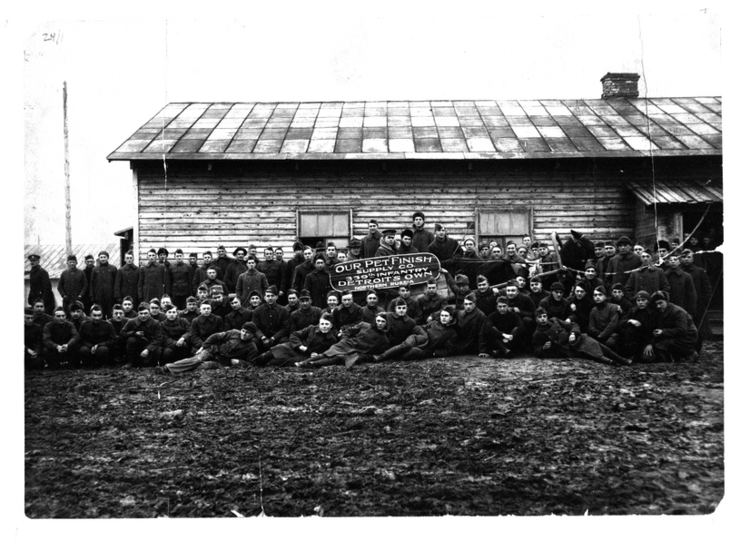Active 1918-1919
1942-1945 Branch United States Army Size Regiment | Country United States Type Infantry | |
 | ||
Engagements Russian Civil War
Polar Bear Expedition | ||
The 339th Infantry Regiment was an infantry regiment of the United States Army, raised for service in World War I, that served in the North Russia Intervention and World War II.
Contents
North Russia intervention
The 339th Regiment was created in June 1918, composed mainly of young draftees, for the purpose of fighting on the Western Front in France. Most of the 4,487 men were from Michigan, but some 500 draftees from Wisconsin were included. It was commonly referred to as "Detroit's Own". They were sent to fight the Bolsheviks in Northern Russia. They were nicknamed the “polar bears” because of their service there.
On July 30 1918, Gen Pershing, by order of President Wilson, chose the 339th Infantry Regiment, the 1st Battalion of the 310th Engineers, the 337th Field Hospital, and the 337th Ambulance Company, (all from the 85th Division) to form the Murmansk Expedition. These units are assembled and equipped at Cowshott Camp, Surrey, England. August 9, 1918, with Lt Col George Evans Stewart (later Col) of the 339th Inf as commanding officer of the expedition. Aug 27, 1918, the expedition, 143 officers and 4,344 enlisted men, sails from Newcastle-on-Tyne, England, arrives Archangel, North Russia, September 4, where, with other Allied forces, it becomes part of the command of Maj Gen F. C. Poole, British Army. American Headquarters is established at Archangel. Distribution of American troops begins along a front 450 miles long, extending from Onega in the west to Pinega in the east, and at some points 200 miles distant from the Archangel base. Elements of the 339th Infantry and attached units operate with the Allied forces to cover the main avenues of approach to Archangel from the south as follows: on the Onega River near Chekuevo; on the railway from Archangel to Vologda near Obozerskaya; on the Vaga River at Pinega. These forces were opposed by the Soviet Sixth Army. September 30, 1918, reinforcements, consisting of 17 officers and 486 enlisted men from the 85th Division, join. Between September 1918 and May 1919 many minor operations take place against the Soviet forces resulting in more than 500 American casualties. October 26, 1918, Major General Edmund Ironside, British Army, succeeds Major General Poole as commander of the Allied force. April 9, 1919, the American contingent is again redesignated, becoming the"American Expeditionary Force, North Russia"; Brig Gen Wilds P. Richardson assumes command of all American troops in North Russia, supreme command however continuing with the British. During May the Archangel contingent is concentrated in the region of that town preparatory to return to the United States. June 3, 1919, the contingent begins moving via Brest to the United States. June 27, 1919, last element, the 1st Battalion of the 310th Engineers, sails for Brest, en route to United States.
In April of 1919, the enlisted men Company I mutinied, challenging their officers and refusing orders. Chief of Staff Gen. March attributed the action "Bolshevik Propaganda" at a press conference on April 12. Company I consisted almost entirely of men from Detroit.
Only after leaving England, were the men told of their destination. Spanish Influenza broke out on two of the three transports, and seventy-two men would eventually succumb to the disease or resultant pneumonia.
World War II
The 339th Infantry Regiment was later reactivated in 1942, during World War II, to serve in the European theater, fighting in the Allied campaign in Italy from 1944 to 1945. The regiment was assigned to the 85th Infantry Division. As a unit of the 85th Infantry or "Custer" Division, the 339th Infantry saw combat service in Italy from March 1944 until the surrender of German forces in May 1945.
Distinctive unit insignia
A gold color metal and enamel device 1 5/32 inches (2.94 cm) in height consisting of a shield blazoned: Azure a polar bear statant on an ice cake Argent: on a canton Or a fess Sable between three martlets of the like two and one. Attached below and to the sides a Gold scroll inscribed "Штыкъ рѣшаетъ" in Blue letters.
The polar bear on its blue background is copied from the unofficial shoulder patch of the North Russian Expeditionary Force, of which this Regiment was a part during the years 1918-1919. The Regiment, organized in 1917, was made up to a large extent of men from Detroit, and was known locally as "Detroit's Own." The canton bears a part of the coat of arms of Cadillac, the founder of Detroit, and is symbolic of the origin of the Regiment and of its 1924 allocation. The motto is pronounced as though spelled in English "shtyk reshayet" (Russian pronunciation: [ˈʂtɨk rʲɪˈʂajɪt]). Literally translated it is the "The bayonet settles it," freely translated it may be rendered "We Finish With The Bayonet."
The distinctive unit insignia was originally approved for the 339th Infantry Regiment on 9 June 1924. It was redesignated for the 339th Regiment and amended to include the motto on 5 August 1960.
